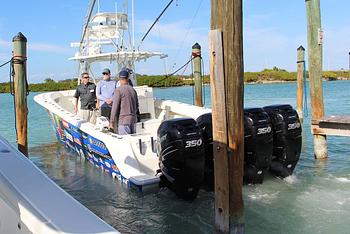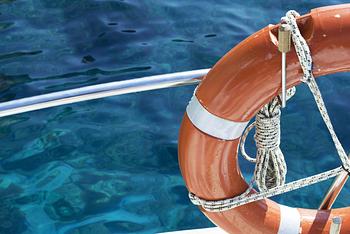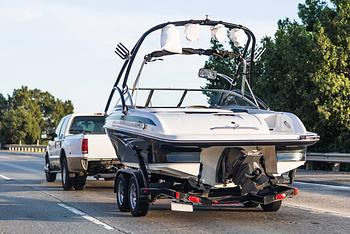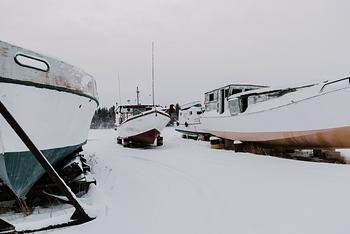Which is better, an outboard engine or an inboard engine? It’s a hotly debated topic among boaters, and although outboards have handily gained ground in the marketplace during the past few decades, each still has a loyal following. You can find owners of both adamant that their choice is the best, but as with most things boating, the answer isn’t always clear cut and while there are definitely pros and cons to both types of engines, ultimately it boils down to what kind of boat you want, where you plan to use it, and how you want use it. So, what are the advantages and disadvantages of each?

What is an Outboard Motor?
An outboard motor is one which is fixed to the exterior of a boat at the transom. Popular on all types of recreational boats, the outboard motor has an upper section where the power head is located, a middle section with a motor mount (which is bolted to the transom), and a lower section with a gearcase and propeller. Small outboards might have a tiller for steering, while most of those over 30 or 40 horsepower have forward steering stations. Outboards can be tilted out of the water when not in use which prevents marine growth from fouling them and reduces corrosion. They can also be easily unbolted and removed from a boat, which makes repowering boats with outboards very easy.
There are a handful of diesel outboards offered on the market and there’s also a growing number of electric outboards. However, the vast majority of the outboards on the market today are gasoline powered. So for our purposes, this discussion will revolve around gasoline outboards. Check out our guide on Best Outboard Motor Brands for Your Boat.
What is an Inboard Motor?
In contrast to the outboard engine, and as the name implies, the inboard engine is positioned inside the hull of the boat. It is comprised of two main components, the engine itself and the running gear. Found on larger boats which require big diesel engines, watersports boats, and some runabouts or cruisers, the inboard engine offers a low center of gravity (which may improve the ride in some cases), higher horsepower offerings, and in sometimes improved fuel economy. Some mechanically inclined boaters like having an inboard since they’re more like automotive engines (many are marinized powerplants produced for cars) and they may feel more comfortable working on them. However, as automotive engines have become more and more complex this advantage has begun to fade with newer models.
There are multiple kinds of inboard engines:
- Straight-shaft Inboard: With a straight shaft inboard engine, the propeller doesn’t steer the boat and it’s affixed to a propshaft. A separate rudder controls the steering. A similar arrangement is the V-Drive, where the engine faces forward and a V-shaped coupling connects to the aft-facing propshaft. This allows the engines to be mounted far back against the transom, increasing the space available for a cabin.
- Stern-drive (also called inboard-outboard or I/O): Stern-drives locate the engine inside the boat and against the transom, but the drive system (with the outdrive and propeller) goes through the transom of the boat and sticks out the back, essentially making it part inboard and part outboard. Popular on runabouts and cruisers, their main advantage is that the drive units provide steerable thrust (for better maneuverability than a rudder) and the drives can be trimmed up and down, but a big swim platform can still be added without an outboard getting in the way.
- Jet Drive: This is an inboard engine that does not use a propeller propulsion system, but instead uses a waterjet to power the boat. Jet drive systems power personal watercraft, a few runabouts, and a handful of larger boats.
- Pod Drives: Pod drives have an inboard engine coupled to a “pod” with the running gear going straight down through the bottom of the boat. The pod is steerable, so thrust can be directed and handling is vastly enhanced.

Differences between Inboard and Outboard Engines
When it comes to comparing inboard and outboard engines we have to look at a whole host of criteria. Ultimately, there is no best option, but a best option for your boat and your needs.
Appearance
These days with the improved fuel efficiency of modern four-stroke outboards there is little difference when it comes to the fuel efficiency of an inboard engine and that of an outboard. However, in some cases the inboard engine has an edge, especially when it comes to diesel inboards versus gasoline outboards. Gasoline stern drives also tend to have a slight edge over outboards.
Fuel Efficiency
These days there is very little in it when it comes to the fuel efficiency of an inboard engine and that of an outboard. However, while that’s true at face value, in practice the weight of your boat will determine how fuel efficient it is. A heavy boat using an outboard engine will have poor fuel efficiency, while an inboard would offer more power and therefore less fuel usage. Ultimately, the inboard engine is considered to be the most fuel efficient.
Performance and randling
Performance-wise outboards usually win the race, as long as horsepower is equal. And in single-engine applications they usually offer better handling and maneuverability as well. That said, twin inboards often have better dockside handling than twin outboards, pod drives offer even better close-quarters maneuvering, and since inboard engines usually sit deeper in the boat and lower its center of gravity, some inboard boats run smoother and gain stability.
Maintenance and replacement
Maintenance is a big deciding factor when choosing between inboards and outboards, especially when it comes to saltwater boats. Where there’s salt, there’s corrosion, and so being able to easily access the engine for maintenance and cleaning, as well as being able to lift it completely out of the water and store it throughout winter means the outboard is the clear winner here. Inboard engines are harder to access, and are bolted inside the hull of the boat, meaning they are more susceptible to corrosion. Having said that, outboard engines are exposed to the weather and elements, meaning they require more maintenance to keep them in good condition.
When it comes time to replace your engine, it is perhaps no surprise that outboard engines are easier to replace, as they simply unbolt from the boat. In turn, inboards require the boat to be lifted out of the water and it involves a much more complex engineering procedure to replace them.

Safety
When it comes to safety, most of the time it’s a wash between outboards and inboards. Modern marine power systems are incredibly safe and are built to USCG (and most of the time also National Marine Manufacturer Association or CE) standards.However, it should be noted that when comparing gasoline outboards to diesel inboards, diesels do gain an edge as the fuel is much less volatile.
Reliability
A few decades ago inboards were clear winners in this regard, but modern four-stroke outboards are quite technically advanced and are far, far better than those produced prior to the turn of the century. So today, gasoline outboard and inboard engines are more or less equally reliable. That said, diesels again generally have a slight advantage over any gasoline powerplant in this department. It should also be pointed out that stern-drives have some additional reliability challenges in that their complex drive units and couplings add additional points of potential failure and can sometimes prove problematic.
Cost
This is another area where inboards used to have an advantage, but time and technology has turned the tables. Today, on recreational boat models offered with both inboards and outboards, the outboard version generally costs slightly less. Of course, different pricing between manufacturers and model lines make it easy to find an inboard boat that’s less expensive than an outboard boat of the same size and basic type but built by someone else. Still, all other things being equal, outboards generally get the pricing nod.
The Boating experience
The overall boating experience plays a role in deciding which engine to get. If you’re looking for a quiet cruising experience, you’ll be happy to discover that today’s outboards are significantly quieter than they used to be and now rival inboards for noise levels. (Note the exception of some jet drives, which can be loud and high-pitch).
Also remember that outboards can be raised in shallow waters whereas inboards, with the exception of stern-drives, can’t, meaning adventures in shallow coastal areas, lakes, mangroves, or rivers are best with an outboard. Then there’s the swim platform to consider, as the full-beam platforms on inboard boats provide space that an outboard can’t match. But also note that inboards require interior space be dedicated to housing the engines, which means they can cut into the space available for a cabin or stowage.

Photo credit: Mercury Marine
Advantages and Disadvantages of Outboard and Inboard Engines
Let’s boil all of this down:
Advantages of outboard engines
- Higher power-to-weight ratio
- Easier maintenance and lower maintenance cost
- Can be raised out of the water
- Requires less draft
- Better handling than inboards that have fixed shafts and rudders as opposed to directed thrust
- Faster performance in most cases
Disadvantages of outboard engines
- Less fuel efficient in some cases
- Can’t have a large swim platform
- Always visible
Advantages of inboard engines
- Can accommodate a full-beam swim platform
- Are fitted in the boat and to some, are therefore more aesthetically pleasing
- Lower center of gravity
- More fuel efficient in some cases
Disadvantages of inboard engines
- Takes up more internal space in the boat
- More expensive and difficult to maintain
- Requires more draft and may be less maneuverable (with fixed running gear)
- May eat into cabin space and/or stowage space

What Boats Usually Have an Inboard Engine?
You will usually see inboard engines on large boats, ski boats, wake boats, and sterndrive inboards on bowriders and medium to large cruisers. While almost any boat can have an inboard or stern-drive engine, it is rare to see them on certain styles of boats including small RIBs, pontoon boats, and small fishing boats.
What Boats Usually Have an Outboard Engine?
As we’ve just seen, it is common to have outboard engines on smaller boats such as small RIBs, Jon boats, pontoon boats and bass boats because the power to weight ratios work best. Years ago it was rare to see outboard boats much over 30’ in length, but as outboards have improved, they’ve come to dominate the market for most types of boats up into the 40’ range and even beyond. Having said that, large center consoles, fishing boats and some large RIBs can have up to four or even five outboards to provide sufficient power and speed.
What are Popular Brands of Inboard and Outboard Engines?
Inboards and outboards are very different, not just in their placement but in their engineering, and most builders focus on one or the other. Some of the biggest brands of outboard engine manufacturers include Mercury, Yamaha, Suzuki, Honda, and Tohatsu. Popular brands of inboard engine manufacturers include Mercury Mercruiser, Scania, Volvo, Indmar, Ilmor, and PCM.
And the Winner is…
As with many things boating, there is not a clear winner and ultimately the size and style of your boat, as well as what you want to use it for, where you plan to store it, and the conditions you want to use it in, will decide whether an outboard engine or inboard engine is the best choice for you.
Related Articles and Guides
18th Jun 2024
How to Dock a Boat with Joysticks, Single Engines, and Twins: Tips and Technique...
20th May 2024
Essential Boat Safety Tips for Every Type of Watercraft
29th Mar 2024
How to Transport Your Boat Four Different Ways
18th Oct 2023





